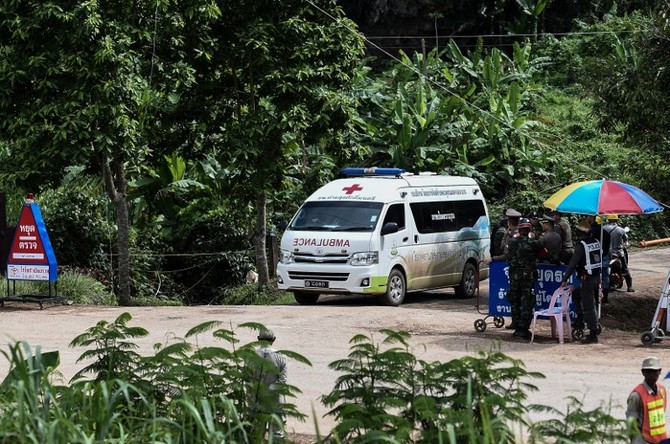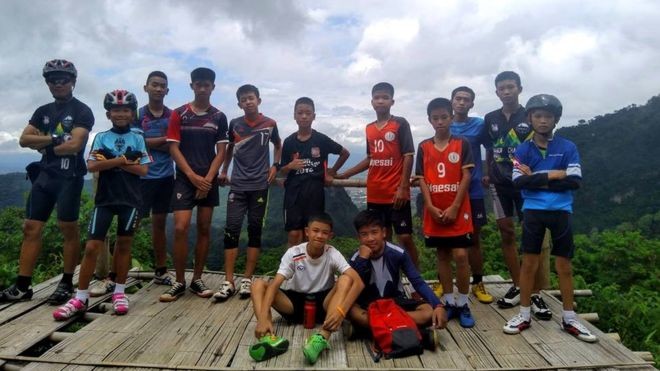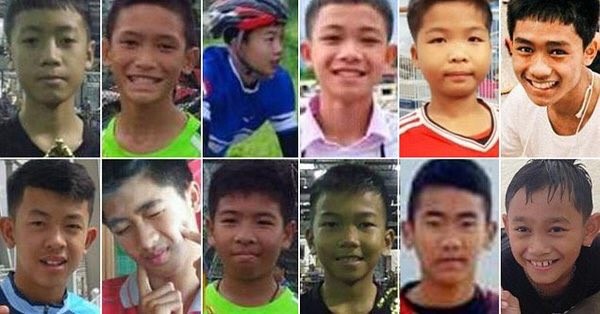MAE SAI: Thailand's navy SEALs say all 12 boys and their soccer coach have been rescued from a flooded cave in far northern Thailand, ending an ordeal that lasted more than two weeks.
They say the four boys and coach rescued Tuesday, after other rescues in the previous two days, are all safe.
The SEALs say they're still waiting for a medic and three Navy SEALs who stayed with the boys to emerge from the cave.
Elite divers on Sunday began the extremely dangerous operation to extract 12 boys and their football coach who have been trapped in a flooded cave complex in northern Thailand for more than two weeks, with some of the rescuers reaching the area where the team is sheltering.
The “Wild Boars” team has been stuck in a cramped chamber several kilometers (miles) inside the Tham Luang cave complex since June 23, when they went in after football practice and were hemmed in by rising waters.
Their plight has transfixed Thailand and the rest of the world, as authorities struggled to devise a plan to get the boys and their coach out through twisting, narrow and jagged passageways that in some places are completely flooded.
Premier League side Manchester United have invited the Wild Boars football team, like the Chilean miners rescued in 2010, to visit Old Trafford following their dramatic rescue on Tuesday.
The dozen players — aged 11 to 16 — and the coach had already received an invitation from FIFA chief Gianni Infantino last week to attend the World Cup final on Sunday in Moscow — although after their traumatic experience they may not be up to the trip physically or mentally.
Rescue operation timeline
TUESDAY 12:00 GMT
Three ambulances, their lights flashing, have been seen leaving the site of the flooded Thai cave where rescuers are involved in an all-out effort to rescue members of a youth soccer team and their coach trapped deep within.
Earlier Tuesday, Thai navy SEALS said a ninth boy had been brought out of the cave on the third day of the rescue effort. The departure of the three ambulances suggests others also have been rescued, but there was no immediate official confirmation.
Rescuers hope to complete their mission Tuesday after rescuing four boys on each of the previous two days. That left four boys and their 25-year-old coach still in the cave.
The 12 boys and their coach were trapped by flooding in the cave more than two weeks ago.
TUESDAY 10:00 GMT
A local government official said that the tenth boy was rescued from the cave.
"The 10th is at the cave entrance on the way to the field hospital," a navy official told AFP requesting anonymity. A local government official confirmed the rescue while a police source, who also did not want to be named, said "the ninth and tenth were about 20 minutes apart."
TUESDAY 04:20 GMT
A Thai public health official says the eight boys rescued from a flooded cave in northern Thailand are in “high spirits” and have strong immune systems because they are soccer players.
Jesada Chokdumrongsuk, deputy director-general of the Public Health Ministry, said Tuesday that the first four boys rescued, aged 12 to 16, are now able to eat normal food.
He said two of them possibly have a lung infection but all eight are generally “healthy and smiling.”
He said, “the kids are footballers so they have high immune systems.”
The second group of four rescued on Monday are aged 12 to 14.
Family members have seen at least some of the boys from behind a glass barrier.
Four boys and their football coach remain in the cave.
MONDAY 12:20 GMT
An aide to the Thai Navy SEAL commander says four boys were brought out of the flooded cave in northern Thailand on Monday and the ongoing rescue operation is over for the day.
The aide, Sitthichai Klangpattana, didn't comment on the boys' health or say how well the operation has gone.
A total of eight of the 12 boys have now been brought out of the treacherous cave system by divers, including four who were brought out on Sunday, when the rescue operation began.
MONDAY 11:50 GMT
A total of four ambulances have left the area around the flooded cave in northern Thailand where members of a youth soccer team have been trapped for more than two weeks, suggesting eight of the 13 trapped people have now been extracted.
Thai officials have been tight-lipped about the rescue operation, and would not comment on how many people were removed Monday.
MONDAY 11:30 GMT
Two more ambulances have been seen leaving the site of a flooded cave in northern Thailand.
That brings to three the number of ambulances that have left the site Monday during the second day of a high-risk operation to bring the boys out of a labyrinth cave system made up of tight passageways and flooded chambers.
MONDAY 10:10 GMT
Thai authorities are being tight-lipped about who was inside an ambulance seen leaving the site of a flooded cave Monday, as they were the night before when four of the 13 people trapped inside the underground complex were rescued.
Multiple calls to senior government officials and military personnel leading the operation to rescue the members of the youth football team rang unanswered Monday evening.
On Sunday, officials waited until several hours after the rescued boys had been transported to hospitals to announce their rescue.
MONDAY 09:41 GMT
Thai public television has aired live video of a medivac helicopter landing close to a hospital in the city of Chiang Rai, near the site of the cave where a youth football team has been trapped for more than two weeks.
Medics appeared to remove one person on a stretcher but hid the person’s identity behind multiple white umbrellas. An ambulance was seen leaving the scene immediately afterward early Monday evening.
Less than an hour earlier, an ambulance with flashing lights had left the cave complex, hours after the start of the second phase of an operation to rescue the football team
MONDAY 08:25 GMT
Australia’s foreign minister says 19 Australian personnel are involved in the Thailand cave rescue operation including a doctor who’s played an essential part in assessing which boys can leave and in what order.
Foreign Minister Julie Bishop told reporters in Australia that anesthetist and experienced cave diver Richard Harris is working with the Thai medical team inside the cave “to make the decisions about the order in which the boys were to be extracted.”
MONDAY 08:18 GMT
Thai authorities say they have resumed operations to rescue members of a boys’ football team trapped in a flooded cave after successfully getting four of the boys out Sunday.
The chief of the international mission on Monday said he was expecting “good news” shortly.
“All the equipment is ready. Oxygen bottles are ready... in next few hours we will have good news,” Narongsak Osottanakorn told reporters, after announcing the second phase of the rescue bid had begun.
MONDAY 08:07 GMT
Thai authorities say overnight rain did not change the water level in cave where the boys and their coach are trapped.
They said the second phase of the operation of the rescue mission will begin at 11 a.m
“We are using more personnel than yesterday,” said the chief of the rescue mission.
MONDAY 07:58 GMT
Thai authorities say the four boys rescued from the cave on Sunday are hungry but in good health.
Officials said at a news conference that the parents of the rescued boys, whose names have not been released, have not yet been allowed to have physical contact with them, pending more extensive examination of their physical condition.
Eight boys are still inside the cave and along with the team coach. The operation to get them out was supposed to resume only after new oxygen tanks could be placed along their route of escape, which is partially underwater.
MONDAY 07:46 GMT
American tech entrepreneur Elon Musk has proposed a mini-submarine to save the boys trapped inside a flooded Thai cave, floating the idea on social media while linking it to his space exploration business.
After garnering headlines with initial ideas of installing a giant air tube inside the cave complex and using his firm’s penetrating radar to dig holes to reach the boys, Musk’s latest concept is the pod.
“Primary path is basically a tiny, kid-size submarine using the liquid oxygen transfer tube of Falcon rocket as hull,” Musk said in a tweet to his 22 million followers.
“Light enough to be carried by 2 divers, small enough to get through narrow gaps. Extremely robust.”
— Elon Musk (@elonmusk) July 8, 2018
The mini-submarine is due to arrive in Thailand on Monday, Musk wrote.
MONDAY 07:26 GMT
Authorities are preparing to resume extractions of a youth football team from a flooded cave in Thailand a day after four boys were rescued.
There was a heavy but brief downpour Monday morning. New oxygen tanks were being placed in the cave before the second stage of the rescue effort began.
Thailand's interior minister says the same divers who took part in Sunday's rescue of four boys trapped in a flooded cave will also conduct the next operation as they know the cave conditions and what to do.
In comments released by the government, Interior Minister Anupong Paojinda said officials were meeting Monday morning about the next stage of the operation and how to extract the remaining nine people from the cave in the country's north.
Anupong said divers need to place more air canisters along the underwater route to where the boys and their coach have been trapped since June 23. He said that process can take several hours.
He said the boys rescued Sunday are strong and safe but need to undergo detailed medical checks.
SUNDAY 13:54 GMT
The head of the rescue operation has confirmed that the number of boys recued from the Thai cave were four, not six as previously reported by Reuters.
Chiang Rai acting Gov. Narongsak Osatanakorn, who is heading the operation, said the first boy exited the cave at 17:40 local time, adding the four boys have been safely delivered to hospital in Chiang Rai.
“The operation went much better than expected,” Narongsak said at a news conference, adding that the healthiest were taken out first. He said the next phase of the operation would start in 10-20 hours.
He said 90 divers, including 50 foreigners and 40 Thais, are involved in the operation to remove the boys from the cave.
Just after 9 p.m., Thai navy SEALs posted on their Facebook page again, saying: “Have sweet dreams everyone. Good night. Hooyah.”
SUNDAY 12:50 GMT
Six boys have exited a flooded cave in northern Thailand where they have been trapped for more than two weeks, a senior member of rescue operation’s medical team said on Sunday.
Authorities in northern Chiang Rai province began the dangerous mission to bring out the 12 boys and their football coach earlier on Sunday.
SUNDAY 12:15 GMT
Four boys among a group of 13 trapped in a flooded Thai cave reached the rescue base camp inside the complex on Sunday and will walk out soon, the country’s defense ministry spokesman told AFP.
“Four boys have reached chamber three and will walk out of the cave shortly,” Lt. General Kongcheep Tantrawanit said, referring to the area where rescue workers had set up a base.
SUNDAY 11:49 GMT
The first two members of a Thai schoolboy football team have been rescued from the flooded cave where they had been trapped for more than two weeks, a local rescue official said on Sunday.
Authorities in northern Chiang Rai province began the dangerous mission to bring out the 12 boys and their coach earlier on Sunday.
“Two kids are out. They are currently at the field hospital near the cave,” said Tossathep Boonthong, chief of Chiang Rai’s health department and part of the rescue team.
“We are giving them a physical examination. They have not been moved to Chiang Rai hospital yet,” Tossathep told Reuters.
Divers will have to navigate 2.5 miles of dark and tight passageways filled with muddy water and strong currents, as well as oxygen-depleted air pic.twitter.com/DJFXJhXx2z
— Sky News (@SkyNews) July 8, 2018
SUNDAY 11:15 GMT
Two ambulances have left from a cave in northern Thailand, hours after an operation began to rescue 12 youth football players and their coach.
The ambulances were seen Sunday evening, but it was unclear who was inside them.
Chiang Rai province acting Gov. Narongsak Osatanakorn, who is heading the operation, said earlier Sunday that 13 foreign and five Thai divers were taking part in the rescue and two divers will accompany each boy as they’re gradually extracted. He said the operation began at 10 a.m., and it will take at least 11 hours for the first person to be taken out of the cave.
The boys and their coach became stranded when they went exploring in the cave after a practice game June 23. Monsoon flooding cut off their escape and prevented rescuers from finding them for almost 10 days.
SUNDAY 10:50 GMT
Thai authorities say it is unknown when the first group of boys trapped in a flooded cave will begin their dive out of the cave, the key part of a rescue operation underway.
In a statement released late Sunday afternoon, Chiang Rai acting Gov. Narongsak Osatanakorn says "divers will work with medics in the cave to assess the boys' health before determining who will come out first."
He added: "They cannot decide how many of them will be able to come out for the first operation. Based on the complexity and difficulty of the cave environment it is unknown how long it might take and how many children would exit the cave."
SUNDAY 07:45 GMT
“Today is the D-day. The boys are ready to face any challenges,” rescue chief Narongsak Osottanakorn told reporters near the cave site as weather forecasters warned of more monsoon rains late on Sunday that would cause further flooding in the cave.
Narongsak said the first boy was expected to be brought out of the cave by around 9:00 p.m. (1400 GMT) after navigating the planned six-hour journey.
Six boys have exited #Thailandcave and official heading the cave rescue says the next phase of the operation to start in 10-20 hours || https://t.co/v1dYIEzwfG #ThaiCave #ThailandCaveRescue #ThaiCaveRescue pic.twitter.com/3qwkONZmH3
— Arab News (@arabnews) July 8, 2018
However another operation commander said the operation would take two to three days to complete, with the boys and their coach being brought out one-by-one, and that the weather conditions would play a role in determining how long it would take.
The boys, aged from 11 to 16, and their 25-year-old coach were found dishevelled and hungry by British cave diving specialists nine days after they ventured in.
But initial euphoria over finding the boys alive quickly turned into deep anxiety as rescuers raced to find a way to get them out, with Narongsak at one point dubbing the effort “Mission Impossible.”
(With AFP, Reuters and AP)































